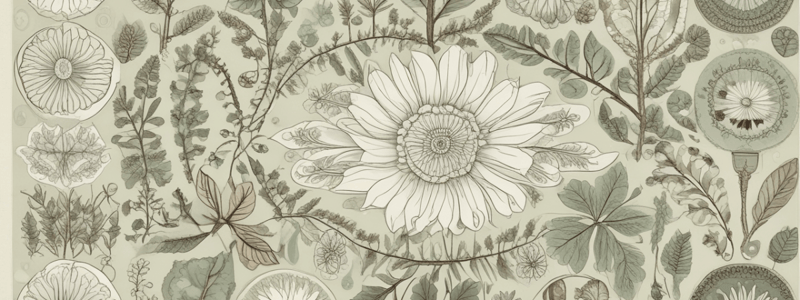Podcast
Questions and Answers
What is the primary function of a seed coat?
What is the primary function of a seed coat?
- To absorb water from the soil
- To produce roots
- To nourish the seed
- To protect the delicate seed from harm (correct)
What is the term for the series of stages a living thing goes through as it grows and changes over the course of its life?
What is the term for the series of stages a living thing goes through as it grows and changes over the course of its life?
- Development phase
- Life span
- Life cycle (correct)
- Growth cycle
What do seedlings use to make their own food?
What do seedlings use to make their own food?
- The sun's energy (correct)
- Pollen
- Rainwater
- Soil nutrients
What is the purpose of pollen in plant reproduction?
What is the purpose of pollen in plant reproduction?
What is the stage of a plant's life cycle characterized by a small plant with a few leaves?
What is the stage of a plant's life cycle characterized by a small plant with a few leaves?
How are seeds typically spread to new places?
How are seeds typically spread to new places?
What is the term for the process of a seed breaking out of its seed coat and beginning to grow?
What is the term for the process of a seed breaking out of its seed coat and beginning to grow?
What is characteristic of a young adult plant?
What is characteristic of a young adult plant?
What is the purpose of roots in a plant?
What is the purpose of roots in a plant?
At what stage of a plant's life cycle does it produce its own seeds?
At what stage of a plant's life cycle does it produce its own seeds?
Flashcards are hidden until you start studying
Study Notes
Plant Life Cycle
- Every plant starts as a seed, which is an undeveloped plant inside a hard outer layer.
- Seeds contain the beginning of new life for a plant and come in various shapes and sizes, growing into the parent plant they came from.
- Seeds are protected by a seed coat and are spread by wind, water, or animals to new places.
Germination & Seedling
- A seed germinates when it finds the right combination of soil, sunlight, and water, beginning to grow and making a new plant.
- The new plant breaks out of the seed coat and grows into a small plant called a seedling.
- Seedlings have a few leaves, spread roots into the soil, and use sun energy to make their own food, soaking up water and nutrients from the soil.
Young Adult Plant
- As the plant continues to grow, it becomes a young adult plant, thicker, taller, and stronger than a seedling.
- Young adult plants have more leaves and deeper roots, looking more like their parent plants but still not old enough to have flowers, fruit, or seeds.
Adulthood & Reproduction
- When a plant reaches a mature size, it's called an adult plant, ready to produce its own seeds.
- Some plants produce pollen in flowers, helping seeds grow, while others produce seeds in cones or flowers and fruit.
- Adult plants spread their seeds by wind, water, or animals, repeating the life cycle.
- The length of a plant's life cycle varies, with some plants like tomato plants having short cycles and others like pine trees having cycles that last many years or centuries.
Studying That Suits You
Use AI to generate personalized quizzes and flashcards to suit your learning preferences.




